At the announcement of 2023’s EA SPORTS F1 23 title, it was touted that this new game, scheduled to release in the middle of June, will have a “revised handling” model for the Formula 1 racing machines.
We at Traxion.GG received an early preview build of the game for testing purposes. Please note that this is an early world-in-progress build of the game, just a small slice of what’s to come. Therefore, what we’ve tested may be tweaked by the time the title is shipped.
Regardless, from what we’ve felt so far, this is most definitely a step in the right direction. We’ve tested the handling in Time Trial mode, one of the few options available in this particular build. Therefore, this feeling is all in a qualifying trim with low fuel, new tyres and maximum ERS bost.
Wheel feel (with zero assists)
First up, we tested the handling on a proper sim racing wheel. The models we’ve used are from MOZA Racing and Fanatec. Right off the bat, we can tell that this is easier to drive than how it felt in the prior release, F1 22. The track of choice is the Hungaroring, and first up, we’ve taken the Red Bull Racing RB19 for a spin.
In the initial settings of F1 23, the car feels much more stable when starting on the default setups than in its predecessor. For someone who might not be used to this type of racing, it’s way quicker now to get familiar, which helps encourage new players.
There is a sense of generally higher grip levels through the corners, with both less understeer and oversteer. It seems that everything is more forgiving, whilst equally also giving you more grip to work with. In short, the car feels planted—it’s nice and balanced throughout the corners, and compared to F1 22, things are manageable and calm.
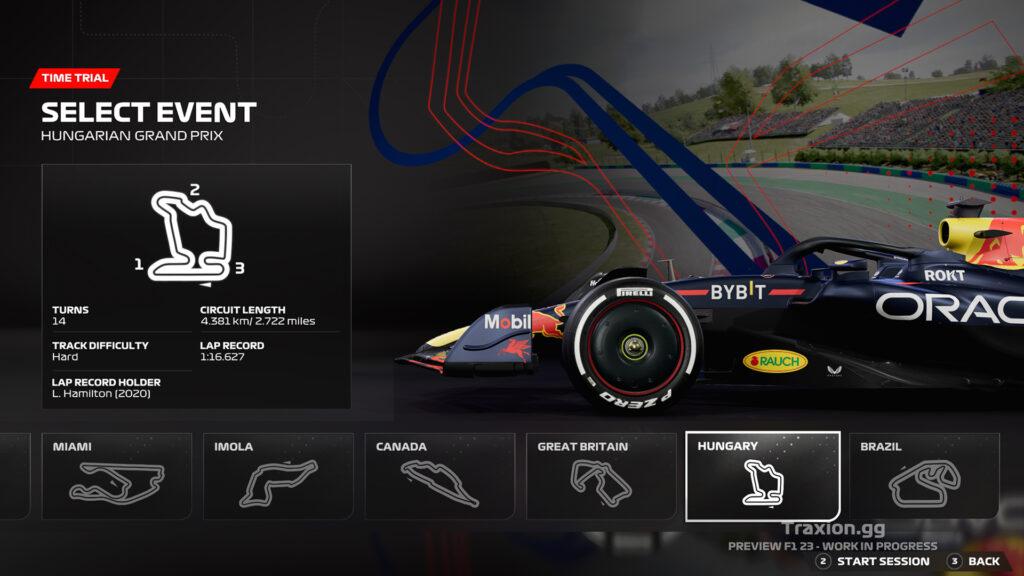
When we get to the corner exit, the game will still bite if you plant the throttle too early or too hard, which is as it should, but the biggest takeaway is that when the backend steps out, you can catch it a lot easier. Not every time, but it’s less unpredictable.
In the previous game, once you lost the rear, you were going for a spin. In this game, if you are quick and sensible about your inputs, you can save it. You’ll still probably lose a bit of time, but if you spin on this game, it’s because you did it wrong. It seldom comes out of nowhere and catches you out when you least expect it.
Even with the better handling, the lap times aren’t necessarily faster, which is also a good sign. It’s just a more fun experience, and we reckon that more players will be able to set down respectable times than they would in last year’s model.
Someone who picks this up and isn’t a regular player might find this more enjoyable, more manageable, and a bit less alien than it was in previous titles, and we have some examples to back that up.
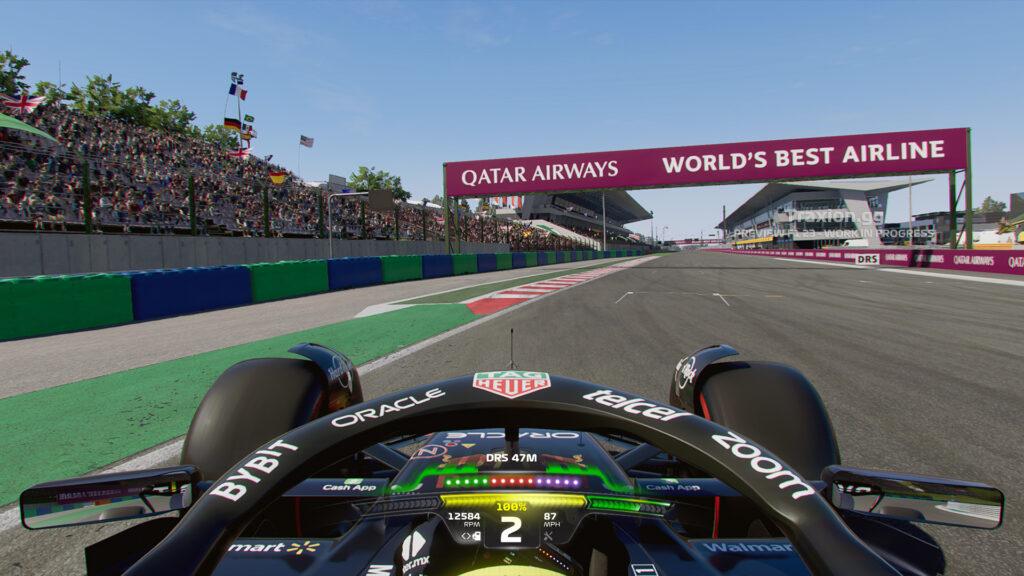
My colleague Piers Prior, for example, hadn’t played any Formula 1 game in the last 10 years, mainly participating on the iRacing platform, yet he still really enjoyed driving this preview version and liked the feeling he got from it. The same goes for our Justin Melillo — not an F1 game fan by any means, but at least he was able to get laps in with consummate ease.
When I did overdrive it and push the limits, I did find a bit more lap time… well, that was before it started going wrong. That type of handling encourages more confident and aggressive actions, as long as players aren’t being totally irresponsible with their inputs.
How different does the force feedback feel?
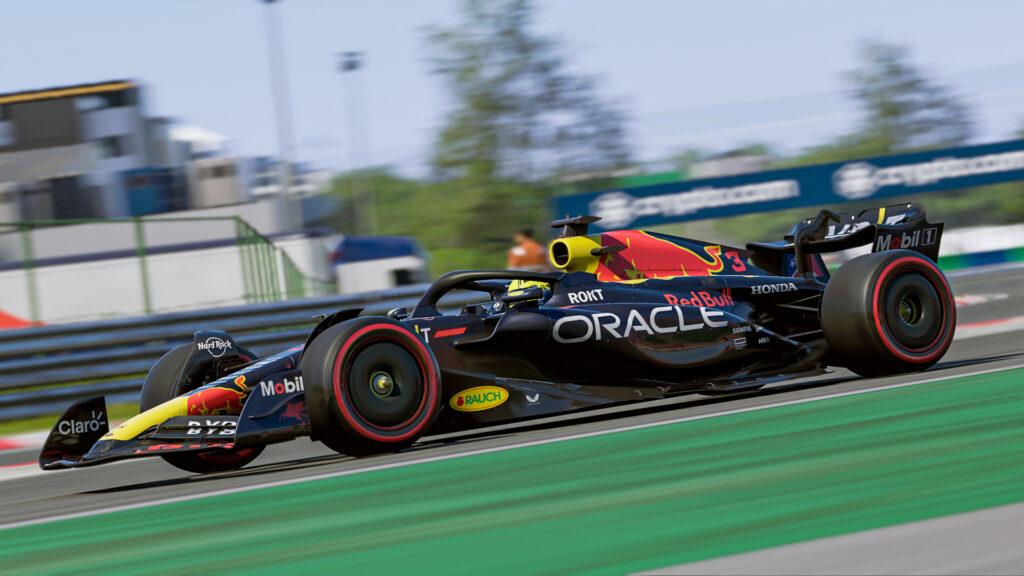
Steering wheel peripheral force feedback has also changed alongside the new handling characteristics, and we have to say that it’s been much improved this go around as well.
Even on identical default force feedback settings from game to game, us at Traxion Towers on the MOZA Racing R21 at 40 per cent power, I felt a far nicer sensation coming through the wheel. Justin also noticed on his Fanatec V2.5 between the games that it just felt like a feeling he was more accustomed to on other games.
There was a heavier general minimum feeling which gave more control and made it feel far more connected to the car than in F1 22. It didn’t feel like it was going to yank out of my hands in the perfectly wrong or right situation.
It weighted up nicely at the right times—there were fewer random fluctuations and guesswork to be had than there was in last year’s title on those identical settings. Out of the box, this feels much closer to driving a single-seater racing car in real life than the previous game, Piers can attest, whilst also being easier to manage.
Overall, the force feedback is a win with more detail, more accuracy, a genuinely nice feeling and a more satisfying sensation. Above all else, it’s simply a fun driving experience in Time Trial mode, and that couldn’t be said for the previous game.
New kerbs
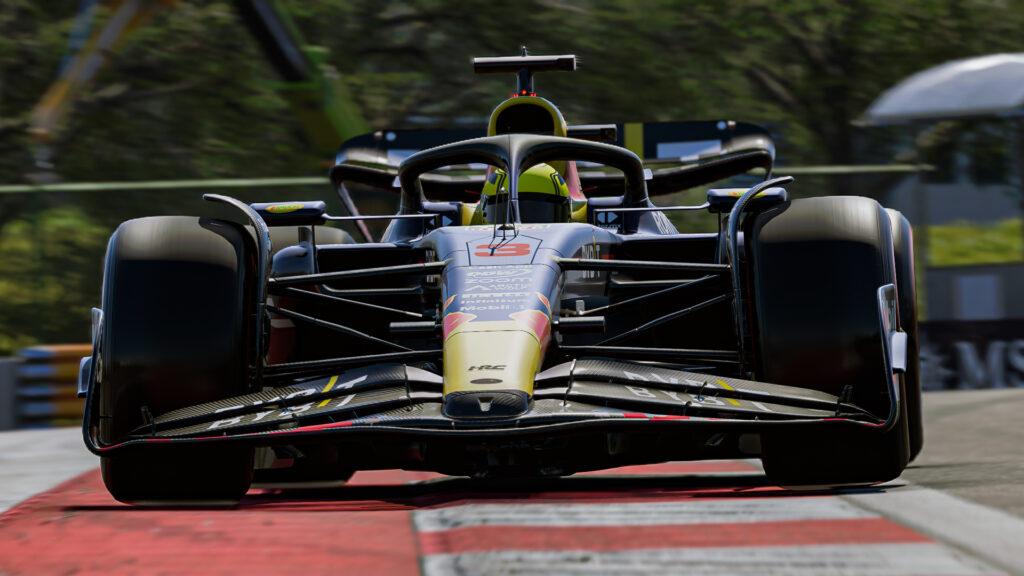
When talking about steering wheel force feedback, it’s also important to discuss where you’ll likely feel it the most, which is over the kerbs. In comparison between the two games, there’s a significantly different reaction now, and in a good way.
It’s easier to ride the lower ones on first impressions. Truthfully, I never really thought too hard about driving on any kerbs on F1 22, so it’s a little harder to compare.
Mid-corner, which for example in this run would be Turn 4 and Turn 5 at Hungary, if I was to mount the inside kerbs on those two corners on F1 22, I would instantly spin, there would be no saving it. In F1 23, I can use all of the kerbs with zero issues. I might get some oversteer there, but only if I was being too greedy with the throttle.
On the exits, it’s about the same. You can trust those lower kerbs. The bigger kerbs, however, can still cause your car to ‘bottom out’ and lose some time, but that is pretty realistic.
If the underside of the car rides the kerb and takes the weight of the car rather than the tyres, you’ll get the effect of being unable to steer for a brief moment, and that could lead to time loss. Like a skateboarder grinding a rail. This is a realistic approach and is also a logical way of punishing kerb abuse without destroying a player’s race.
Points about braking
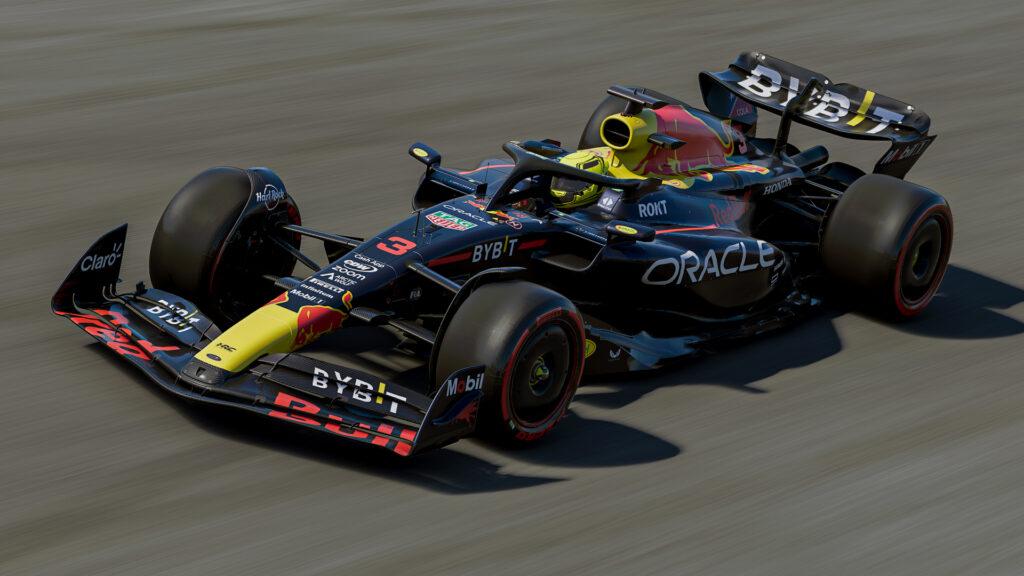
Braking can still be a tricky subject in the new F1 23 title. This is still going to be a game that most drivers will need to use anti-lock brakes (ABS) for, unless you have very load cell pedals and delicate foot control. For context, we were using MOZA Racing’s mid-range load cell pedals (SRP’s) and Fanatec’s V3 Inverted pedals.
An experienced racer with advanced sim racing pedals or a soft and delicate touch can control the brakes properly, avoiding lock-ups and getting the most out of every corner. It is definitely possible and something that we would expect the best of the best to be able to do to maximise their lap times.
However, the ‘Average Joe’ will really struggle without ABS on. Justin says he couldn’t make a lap without them on. Those brakes will lock up a lot, and players will find it hard to get that balance right. Therefore, we recommend that most people give it a go with ABS if they’re just starting out. Plus ça change.
With that said, however, once you have things set up correctly and you can find that right ‘feel’, if you can manage with no ABS, it’s satisfying. It’s most challenging, but in a good way once figured out.
Broader set-up range
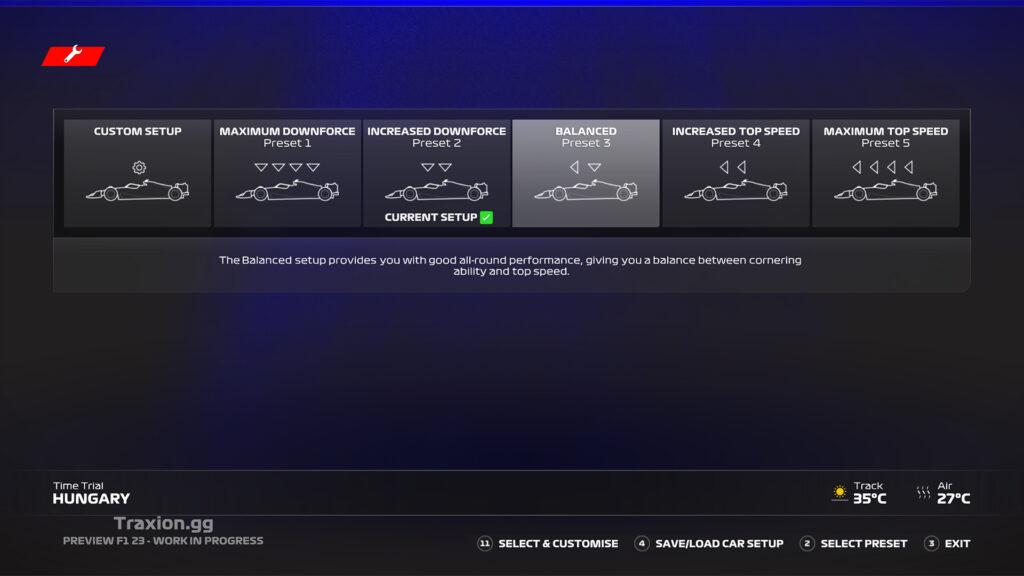
With things tried and tested on the default settings and setup, it was time to try to go even faster. I tried playing around with the setup a bit to get some more esports-style settings in, just to see how it felt and if I could get a better hot lap.
One of the first things I noticed was that the scaling for adjustment is bigger, and thus finer. For example, instead of having suspension setting options between just 1 and 11, it now ranges from 1 to 41.
My guess is that it’s the same, but with different scalings, like 5 out of 11 on the older F1 22 title might be the same as 19 on the 41 scale, for example. Again, that just gives players more flexibility and finer adjustment possibilities without making the setup pages even more complex.
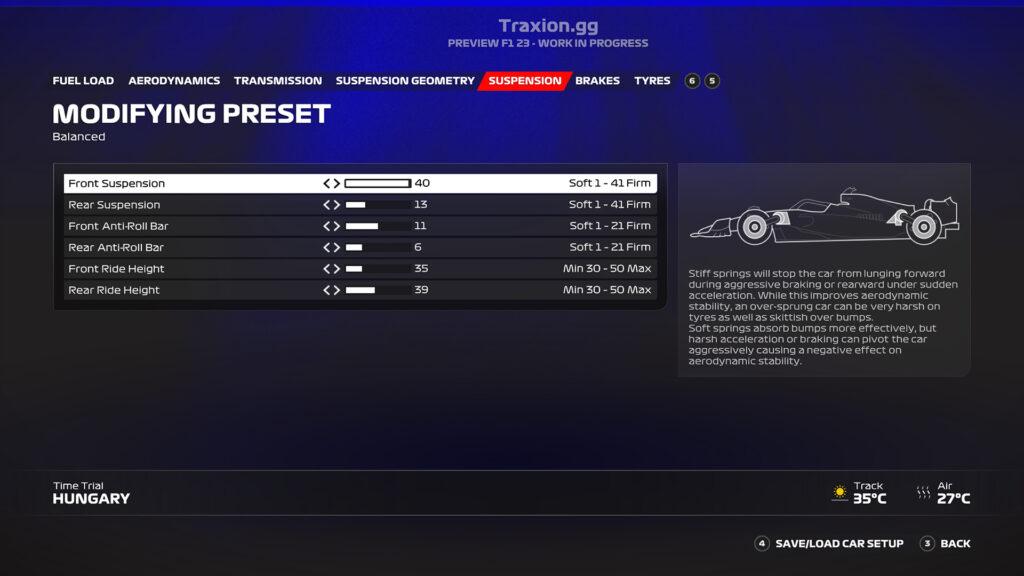
I noticed that more aero definitely made me slower in the straight and faster in the corners, as it should have. A fully rear-ward brake bias, as well as an increased rake, which is a high rear ride height combined with a low front ride height, made me lose the rear under braking. Again, as it should.
Essentially, we have realistic outcomes from realistic changes. It really emphasizes how planted, balanced and controllable the default preset set-ups are, which is great for those looking for a fun and manageable time.
I was able to go quicker on my esports-style set-up, but it was very much harder to drive, and that’s exactly as it should have been.
‘Precision Drive’ with a gamepad
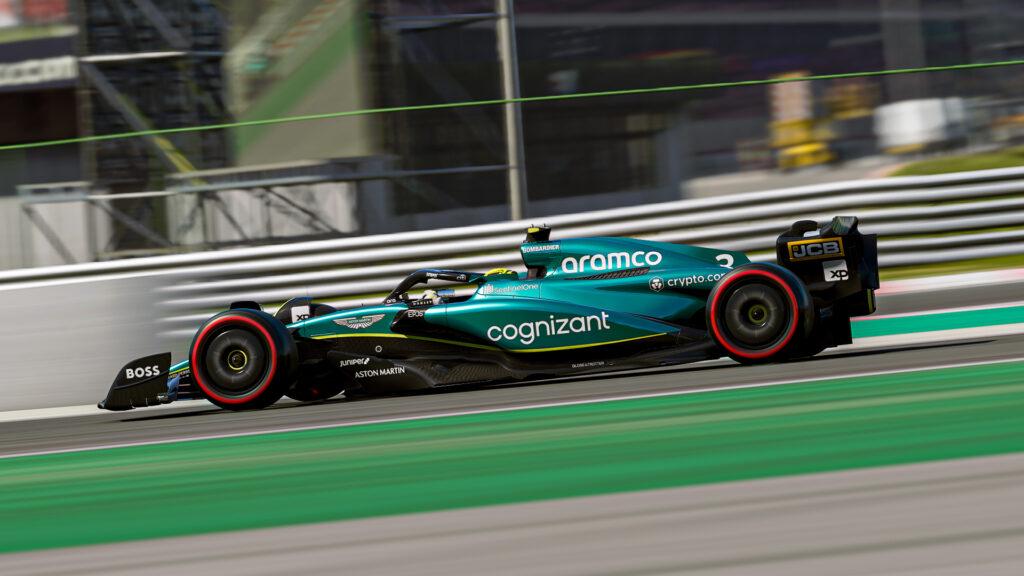
Let’s start off and say that this is not a game that I normally play with a controller. With a wheel, it just always feels better in a lot of simulation-style games.
With that said, I understand that most people actually play the F1 games with a controller and Codemasters is at pains to highlight how this input method has changed year-over-year.
On track, the difference was instantly noticeable. I tried both games back-to-back, and the new game is more, well, precise, and that should be the case based on what we’ve been told.
F1 23 apparently has a new technology called “Precision Drive”, which sounds daft, but it works. The developers claim that it will give you more control, confidence and finesse when using a controller, thanks to a tech rewrite, and I don’t think they are lying about it.
I found I had more control, the game smoothed my inputs nicely. It drove in a more natural, less janky way than it did when trying a controller on F1 22. Even with no assists, I could actually drive it, even able to catch oversteer when it happened. I could also ride on the kerbs without panicking. If I tried that on the previous game, I wouldn’t make a lap.

Essentially, the positive step forwards we experience with a steering wheel carry over to the controller as well. With low traction control and ABS on, it was even easier, and I honestly found it to be an enjoyable experience. It’s still nowhere near as precise as it would be in using a wheel, and directional changes will never be as easy, but it’s a noticeable step forward.
Overall, this preview build for F1 23 felt like a strong improvement from F1 22, and if this is what we get in the final version of F1 23 when it releases next month, we may be in for something truly special.
F1 23 releases on 16th June, 2023, for PlayStation 5, PlayStation 4, Xbox Series X|S, Xbox One and Steam via PC. Pre-orders are available now.






Chat with the Community
Sign Up To CommentIt's completely Free